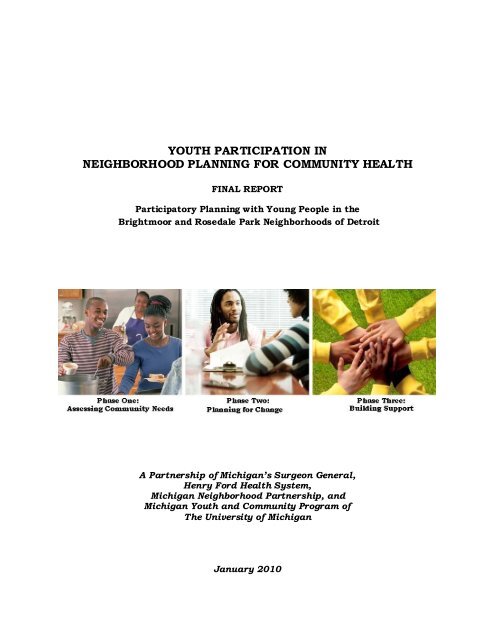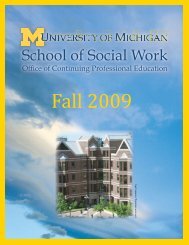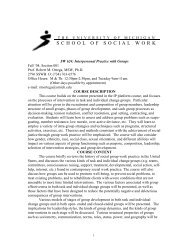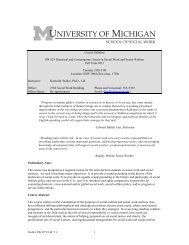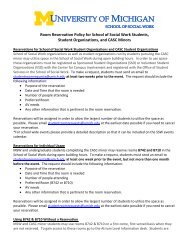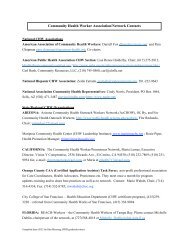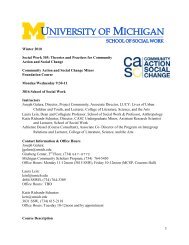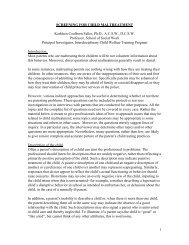Youth Participation in Neighborhood Planning for Community Health
Youth Participation in Neighborhood Planning for Community Health
Youth Participation in Neighborhood Planning for Community Health
Create successful ePaper yourself
Turn your PDF publications into a flip-book with our unique Google optimized e-Paper software.
YOUTH PARTICIPATION IN<br />
NEIGHBORHOOD PLANNING FOR COMMUNITY HEALTH<br />
FINAL REPORT<br />
Participatory Plann<strong>in</strong>g with Young People <strong>in</strong> the<br />
Brightmoor and Rosedale Park <strong>Neighborhood</strong>s of Detroit<br />
A Partnership of Michigan’s Surgeon General,<br />
Henry Ford <strong>Health</strong> System,<br />
Michigan <strong>Neighborhood</strong> Partnership, and<br />
Michigan <strong>Youth</strong> and <strong>Community</strong> Program of<br />
The University of Michigan<br />
January 2010
YOUTH PARTICIPATION IN<br />
NEIGHBORHOOD PLANNING FOR COMMUNITY HEALTH<br />
We are pleased to present the report of an <strong>in</strong>itiative to <strong>in</strong>volve young people <strong>in</strong><br />
neighborhood plann<strong>in</strong>g <strong>for</strong> community health <strong>in</strong> the Brightmoor and Rosedale Park<br />
neighborhoods of Detroit.<br />
The <strong>in</strong>itiative was undertaken by a team of neighborhood residents of high school age,<br />
with adult assistance, through a partnership of Michigan’s Surgeon General, Henry<br />
Ford <strong>Health</strong> System, Michigan <strong>Neighborhood</strong> Partnership, and Michigan <strong>Youth</strong> and<br />
<strong>Community</strong> Program of the University of Michigan.<br />
The report summarizes methods that were employed to conduct a community<br />
assessment, identify priority steps <strong>for</strong> action, and build support <strong>for</strong> implementation. It<br />
describes ways to make the community a healthier place to live, address disparities <strong>in</strong><br />
access to community health, and strengthen social justice through neighborhood<br />
plann<strong>in</strong>g. Special emphasis was placed upon activities <strong>for</strong> the Westside <strong>Health</strong><br />
Resource Center owned by Henry Ford <strong>Health</strong> System.<br />
Young people report that they are ready <strong>for</strong> a healthier community. They want safer<br />
streets, places <strong>for</strong> exercise, and community education about healthy eat<strong>in</strong>g. They are<br />
prepared to learn more about health codes, meet with store owners, lobby elected<br />
officials, and make public presentations.<br />
They report steps to <strong>for</strong>m a neighborhood health plann<strong>in</strong>g group, conduct a large-scale<br />
health education and public awareness program, and organize community health<br />
dialogues as a way to raise awareness. There is need to tear down vacant lots,<br />
organize service projects, and build support among stakeholders. They identified<br />
specific activities <strong>for</strong> the health center, and argued <strong>for</strong> community meet<strong>in</strong>gs <strong>for</strong> further<br />
program plann<strong>in</strong>g.<br />
PROJECT LEADERSHIP<br />
Brett Beckerson was project coord<strong>in</strong>ator and played the primary role <strong>in</strong> plann<strong>in</strong>g,<br />
implementation, and evaluation of the project.<br />
<strong>Youth</strong> team members <strong>in</strong>cluded David Edwards, Rég<strong>in</strong>e Jimmerson, and Takeyah<br />
Bowers.<br />
The project was co-directed by Barry Checkoway and Dennis Talbert, with<br />
coord<strong>in</strong>ation by Bridget Christian.<br />
Ryan Neloms served as community youth advisor.<br />
Kimberlydawn Wisdom and Barbara Blum served as project advisers.<br />
The report was prepared by Brett Beckerson and Barry Checkoway.<br />
2
YOUTH PARTICIPATION IN<br />
NEIGHBORHOOD PLANNING FOR COMMUNITY HEALTH<br />
SUMMARY<br />
We are pleased to present the report of an <strong>in</strong>itiative to <strong>in</strong>volve young people <strong>in</strong><br />
neighborhood plann<strong>in</strong>g <strong>for</strong> community health, <strong>in</strong> the Brightmoor and Rosedale Park<br />
neighborhoods of Detroit. The report summarizes ef<strong>for</strong>ts to conduct a community<br />
assessment, identify priority steps <strong>for</strong> action, and build support <strong>for</strong> implementation. It<br />
describes steps that will make the community a healthier place to live, address<br />
disparities <strong>in</strong> access to community health, and strengthen social justice through<br />
neighborhood plann<strong>in</strong>g.<br />
The <strong>in</strong>itiative was undertaken by a team of neighborhood residents of high school age,<br />
with adult assistance, through a partnership of Michigan’s Surgeon General, Henry<br />
Ford <strong>Health</strong> System, Michigan <strong>Neighborhood</strong> Partnership, and Michigan <strong>Youth</strong> and<br />
<strong>Community</strong> Program of the University of Michigan.<br />
PURPOSE<br />
The purpose of the partnership is to engage young people <strong>in</strong> neighborhood plann<strong>in</strong>g<br />
<strong>for</strong> community health <strong>in</strong> the Brightmoor-Rosedale Park area of Detroit. The<br />
partnership aims to:<br />
• Engage young people <strong>in</strong> neighborhood plann<strong>in</strong>g <strong>for</strong> community health;<br />
• Enable youth to ga<strong>in</strong> experience with leadership skills;<br />
• Gather <strong>in</strong><strong>for</strong>mation <strong>for</strong> program development <strong>in</strong> a neighborhood facility;<br />
• Build relationships with community collaborators; and<br />
• Establish a program model <strong>for</strong> adaptation nationwide.<br />
3
GENERATION WITH PROMISE<br />
Special emphasis of the partnership is placed on <strong>in</strong>itiatives consistent with Generation<br />
With Promise (GWP), a program that makes the community a healthier place to live,<br />
addresses disparities <strong>in</strong> access to community health, and strengthens social justice<br />
through neighborhood plann<strong>in</strong>g, program implementation, and public policy. Specific<br />
themes <strong>in</strong>cluded Eat<strong>in</strong>g Better, Mov<strong>in</strong>g More, and Feel<strong>in</strong>g Safer.<br />
Partners discuss ways to <strong>in</strong>volve young people, teachers, and staff members from GWP<br />
neighborhoods schools, <strong>in</strong> addition to other organizational stakeholders. Thus this<br />
work provides an <strong>in</strong>novative example of apply<strong>in</strong>g GWP to community health <strong>in</strong> a<br />
specific neighborhood.<br />
GWP middle school student action team members from the Brightmoor - Rosedale<br />
Park area participate <strong>in</strong> the project. Unive rsity students help facilitate high school<br />
and middle school student <strong>in</strong>volvement <strong>in</strong> the project, offer<strong>in</strong>g opportunities <strong>for</strong><br />
positive youth development at multiple educational levels.<br />
MICHIGAN NEIGHBORHOOD PARTNERSHIP<br />
Michigan <strong>Neighborhood</strong> Partnership (MNP) assists with recruitment, selection and<br />
support of neighborhood youth team members. MNP leadership and staff members<br />
provide orientation to the neighborhood, background <strong>in</strong><strong>for</strong>mation on organizations,<br />
and liaisons with parents and other adults.<br />
UNIVERSITY OF MICHIGAN<br />
Participants develop leadership skills <strong>for</strong> team build<strong>in</strong>g and program plann<strong>in</strong>g through<br />
<strong>in</strong>volvement <strong>in</strong> the University of Michigan’s Michigan <strong>Youth</strong> and <strong>Community</strong> Program<br />
and its <strong>Youth</strong> Dialogues on Race and Ethnicity <strong>in</strong> Metropolitan Detroit. University<br />
students supervise community assessment and neighborhood plann<strong>in</strong>g activities, and<br />
facilitate <strong>in</strong>tergroup dialogues that strengthen their group <strong>for</strong>mation and diversity<br />
skills. They also facilitate workshops to prepare youth team members <strong>for</strong> community<br />
assessment and program plann<strong>in</strong>g.<br />
METHODOLOGY<br />
<strong>Youth</strong> participation <strong>in</strong> neighborhood plann<strong>in</strong>g <strong>for</strong> community health is a three phase<br />
project of a partnership of Michigan’s Surgeon General, Henry Ford <strong>Health</strong> System,<br />
Michigan <strong>Neighborhood</strong> Partnership and the Michigan <strong>Youth</strong> and <strong>Community</strong><br />
Program of the University of Michigan. Follow<strong>in</strong>g is a logic model of the entire project.<br />
4
PHASE ONE:<br />
ASSESSING COMMUNITY NEEDS<br />
In partnership with community collaborators,<br />
we <strong>for</strong>med a team of neighborhood youth of<br />
high school age, prepared them to conduct<br />
community-based research, and enabled them<br />
to discuss health policies and plans <strong>for</strong> two<br />
Detroit neighborhoods.<br />
The work was consistent with the themes<br />
associated with the Surgeon General’s<br />
Generation with Promise program: Eat<strong>in</strong>g<br />
Better, Mov<strong>in</strong>g More, and Feel<strong>in</strong>g Safer. The<br />
last theme <strong>in</strong>cluded underage smok<strong>in</strong>g,<br />
dr<strong>in</strong>k<strong>in</strong>g and violence <strong>in</strong> their communities.<br />
Seven high school aged youth were identified by community members <strong>in</strong> the<br />
Brightmoor and Rosedale Park neighborhoods of Detroit. The young people were<br />
selected <strong>in</strong> consultation with Michigan <strong>Neighborhood</strong> Partnership, Rosedale Park<br />
Baptist Church, and Michigan’s Surgeon General. They were selected <strong>for</strong> their<br />
commitment to neighborhood improvement, will<strong>in</strong>gness to participate <strong>in</strong> all activities,<br />
and ability to operate <strong>in</strong> a cohesive group.<br />
We conducted research tra<strong>in</strong><strong>in</strong>g workshops to provide practical skills and prepare the<br />
team. Team members developed skills to ask questions, gather <strong>in</strong><strong>for</strong>mation, and<br />
assess f<strong>in</strong>d<strong>in</strong>gs. The tra<strong>in</strong><strong>in</strong>g was led by University of Michigan facilitators, us<strong>in</strong>g<br />
Participatory Evaluation with Young People as a curricular guide.<br />
Team members spent 8 weeks gather<strong>in</strong>g <strong>in</strong><strong>for</strong>mation <strong>in</strong> the neighborhoods, employ<strong>in</strong>g<br />
some comb<strong>in</strong>ation of observations, <strong>in</strong>terviews, focus groups, surveys, and photovoice.<br />
Team members participated <strong>in</strong> sessions enabl<strong>in</strong>g them to assess their community,<br />
employ<strong>in</strong>g the follow<strong>in</strong>g techniques:<br />
EATING BETTER MOVING MORE FEELING SAFER<br />
Focus Groups<br />
<strong>Community</strong> Interviews<br />
Store Comparisons<br />
W<strong>in</strong>dshield Survey<br />
<strong>Youth</strong> Survey<br />
<strong>Community</strong> Interviews<br />
6<br />
<strong>Community</strong> Mapp<strong>in</strong>g<br />
<strong>Youth</strong> Center <strong>for</strong> <strong>Health</strong><br />
Design Process<br />
In addition to research activities, team members participated <strong>in</strong> additional leadership<br />
activities to strengthen skills <strong>for</strong> public policy, e.g., program plann<strong>in</strong>g, organizational<br />
development, <strong>in</strong>terpersonal <strong>in</strong>fluence, public presentations, community organiz<strong>in</strong>g,<br />
and coalition build<strong>in</strong>g. They also <strong>in</strong>teracted with youth leaders <strong>in</strong> other communities<br />
<strong>in</strong> metropolitan Detroit.
Team members analyzed their f<strong>in</strong>d<strong>in</strong>gs and discussed policy recommendations. They<br />
collaborated <strong>in</strong> a written report, and will present their f<strong>in</strong>d<strong>in</strong>gs and recommendations<br />
to key stakeholders and the Surgeon General.<br />
The process enabled young people to <strong>in</strong>crease their knowledge of youth participation,<br />
neighborhood plann<strong>in</strong>g, and community health. They strengthened skills <strong>in</strong><br />
community assessment, program plann<strong>in</strong>g, and organizational development. They set<br />
goals, assessed alternatives, and identified programs and services <strong>in</strong> a health system<br />
facility.<br />
Young people also strengthened their participation at the neighborhood leve l. They<br />
developed substantive knowledge and practical skills to address health problems and<br />
policy issues that affect neighborhood residents<br />
In an area tend<strong>in</strong>g toward racial segregation, young people participated <strong>in</strong> <strong>in</strong>tergroup<br />
dialogues with other youth who were different from themselves.<br />
Focus Groups<br />
EATING BETTER<br />
Team members participated <strong>in</strong> a focus group emphasiz<strong>in</strong>g eat<strong>in</strong>g better led by nearpeer<br />
facilitators <strong>in</strong> which they discussed the follow<strong>in</strong>g questions:<br />
What are healthy and unhealthy foods?<br />
Team members were asked to bra<strong>in</strong>storm all of the healthy and unhealthy foods that<br />
they could imag<strong>in</strong>e. Follow<strong>in</strong>g are their thoughts about health and unhealthy foods:<br />
• “Unhealthy foods are all processed foods with<br />
lots of salt or sugar or fat (grease).”<br />
• “<strong>Health</strong>y foods are natural foods like fruits,<br />
veggies, and all meats.”<br />
• “Breads may or may not be good <strong>for</strong> you.”<br />
• “Fast food can be good <strong>for</strong> you sometimes, but<br />
you cannot eat it twice a day.”<br />
• “Red meat may not be good <strong>for</strong> you all the<br />
time, but it is “okay” if it is cooked at home.”<br />
Participants responded that they learn about healthy eat<strong>in</strong>g from their families,<br />
through television, and <strong>in</strong> school. Follow<strong>in</strong>g are some of what they said that they<br />
learned from family members:<br />
• “You do not have to exercise if you eat right.”<br />
• “You can eat whatever you want, but you need to exercise.”<br />
• “Red meat is better <strong>for</strong> you then white meat as long as it is steak”.<br />
• “It is better to cook with butter because it is more natural than<br />
margar<strong>in</strong>e.”<br />
7
What messages do they receive on the way to school?<br />
Team members discussed the billboards <strong>for</strong> fast food and alcohol that they see on<br />
their way to school, about which one young person observed: “They are target<strong>in</strong>g us<br />
because we’re black. They don’t want us to live as long as them. And they want our<br />
lives to be unhappy and unhealthy.”<br />
The young person cont<strong>in</strong>ued that “they” are “the man,” mean<strong>in</strong>g (white) people with<br />
power.<br />
When team members later were provided with accurate <strong>in</strong><strong>for</strong>mation about healthy food<br />
and healthy physical activity dur<strong>in</strong>g a special dialogue, they agreed that young people<br />
need more accurate <strong>in</strong><strong>for</strong>mation on healthy choices.<br />
<strong>Community</strong> Interviews<br />
Each team member <strong>in</strong>terviewed five community members – e.g., family members,<br />
neighbors – and asked about the five priority places where they shop <strong>for</strong> their<br />
groceries and why.<br />
They were prepared <strong>for</strong> this by practic<strong>in</strong>g <strong>in</strong>terviews <strong>in</strong> dyads and <strong>in</strong> front of the group.<br />
Upon completion, they met and mapped their f<strong>in</strong>d<strong>in</strong>gs on large sheets of paper, as<br />
follows:<br />
Grocery Stores<br />
1. Wal-Mart<br />
29555 Plymouth, Livonia<br />
2. Sam’s Club<br />
22500 W 8 Mile, Southfield<br />
3. Kroger<br />
9369 Telegraph Rd,<br />
Red<strong>for</strong>d, MI<br />
4. Foodland<br />
18551 Grand River<br />
Detroit, MI 48223<br />
5. K-Mart<br />
19990 Telegraph, Detroit,<br />
6. Glory Mart<br />
19150 Telegraph Rd,<br />
Detroit<br />
8<br />
Map
Team members found that community members patronized establishments based<br />
primarily on food quality and availability of bulk foods <strong>for</strong> purchas<strong>in</strong>g at reduced<br />
prices. They found that location was less important than quality and price <strong>in</strong> their<br />
shopp<strong>in</strong>g choices - the grocery stores that are closest are not those that are visited<br />
most.<br />
Grocery Store Comparison<br />
Team members visited two grocery stores, one <strong>in</strong> their neighborhood and one <strong>in</strong> a<br />
nearly suburb not normally visited by neighborhood residents. Young people<br />
compared the variety of foods, prices, displays and quality, <strong>in</strong>clud<strong>in</strong>g expiration dates,<br />
color, smell, and texture. They discussed their f<strong>in</strong>d<strong>in</strong>gs as follows.<br />
Urban Store Suburban Store<br />
Variety None. Fruits & Vegetables that<br />
many had never seen.<br />
Expiration Dates Most meats expire that day. Most meats expire <strong>in</strong> 2.5 days<br />
Color, Smell, Texture Food smelled. Meat is Everyth<strong>in</strong>g seemed well<br />
bloody and some packag<strong>in</strong>g<br />
is fall<strong>in</strong>g apart.<br />
packaged.<br />
Price Manager’s special is Most items were 40¢ cheaper<br />
cheapest and expired 8<br />
days ago.<br />
at the suburban store.<br />
Other<br />
Refrigeration sections were There were posters on the<br />
not very cold. Unhealthy vitam<strong>in</strong>s <strong>in</strong> the produce and<br />
food is mixed healthy food. how to cook it properly.<br />
Team members reported that they experienced racial profil<strong>in</strong>g at the suburban store.<br />
Despite this, they said that they would prefer shopp<strong>in</strong>g <strong>in</strong> the suburban store rather<br />
than their local grocery store.<br />
W<strong>in</strong>dshield Survey<br />
MOVING MORE<br />
Team members and facilitators traveled by large van down Fenkell Road, a major<br />
thoroughfare which passes through Rosedale Park, Brightmoor, Red<strong>for</strong>d and<br />
Livonia. In small notebooks, they took notes on hous<strong>in</strong>g, boundaries, open spaces,<br />
small bus<strong>in</strong>esses and people. They also completed a w<strong>in</strong>dshield survey created by the<br />
facilitator.<br />
9
The length of the area exam<strong>in</strong>ed was 5.5 miles. The chart below is describes what was<br />
seen with exact quotes from the young people.<br />
We found that young people and their families had “access” to healthy foods by driv<strong>in</strong>g<br />
to some suburban neighborhood grocery stores; that people <strong>in</strong> their community go to<br />
the corner stores <strong>for</strong> everyday produce on a far more regular basis than grocery stores;<br />
and that corner stores were places where drug and alcohol use were prevalent as well<br />
as other activities that made them feel unsafe.<br />
We conducted a w<strong>in</strong>dshield survey <strong>for</strong> 6 miles down Fenkell Street. Young people<br />
found there were more liquor stores, and that they were more heavily clustered, <strong>in</strong><br />
their area than <strong>in</strong> the suburb. The map above shows the number of such store s on<br />
this street, where our w<strong>in</strong>dshield survey took place. Telegraph divides the suburbs<br />
and the city. Brightmoor, a community with a high concentration of youth, is located<br />
between Telegraph and Southfield, where one can see a high concentration of corner<br />
stores as well.<br />
10
Elements Brightmoor Rosedale<br />
Park<br />
“‘Brightmoor “Everyone<br />
Houses’* make up takes care of<br />
Hous<strong>in</strong>g <strong>for</strong> all the burned their home<br />
down ones and and they even<br />
vacant lots. have a sign<br />
welcom<strong>in</strong>g us<br />
here.”<br />
Eliza Park - Stopfel Park -<br />
“I’ve never been <strong>in</strong> “Play ground<br />
Open there.”<br />
stuff is rusted<br />
Space “The grass is taller<br />
than me!”<br />
and old.”<br />
People<br />
Stores<br />
Boundaries<br />
Black. S<strong>in</strong>gle<br />
moms. Bums.<br />
Bored kids. A lot of<br />
people wait<strong>in</strong>g <strong>for</strong><br />
the bus.<br />
“Please tear these<br />
down.”<br />
Lahser. Lots of<br />
graffiti.<br />
All Black.<br />
People cutt<strong>in</strong>g<br />
their grass.<br />
Don’t see a lot<br />
of people<br />
More houses<br />
than stores.<br />
Evergreen.<br />
Sidewalks get<br />
nicer<br />
11<br />
Red<strong>for</strong>d Livonia<br />
“Lot more<br />
apartments and<br />
their homes are<br />
k<strong>in</strong>d of small,<br />
but really nice.”<br />
“Park seems<br />
really safe and I<br />
feel I could<br />
leave my stuff<br />
and it would<br />
still be here.”<br />
Both races,<br />
more white.<br />
Both se xes. All<br />
are walk<strong>in</strong>g<br />
around or<br />
work<strong>in</strong>g.<br />
“Some are<br />
vacant, but<br />
none are<br />
destroyed.”<br />
Telegraph. No<br />
sidewalk at<br />
times<br />
“New and big<br />
houses.”<br />
“Really green<br />
grass”<br />
“Open front<br />
doors”<br />
“School has<br />
nice stuff and it<br />
looks really safe<br />
and lots of room<br />
to do anyth<strong>in</strong>g.”<br />
Two Black<br />
people. Lots of<br />
old people. Lots<br />
of people<br />
runn<strong>in</strong>g.<br />
“They have<br />
Starbucks and<br />
stuff that we<br />
don’t and<br />
they’re really<br />
nice.”<br />
Middlebelt. A lot<br />
more traffic<br />
Three team members said that they have never crossed Telegraph Road <strong>in</strong>to Red<strong>for</strong>d.<br />
They said it looked like a nice place <strong>in</strong><br />
which they might ride bikes. They<br />
appreciated the flowers on the street<br />
and the clean store fronts. They said<br />
that Brightmoor could look like Red<strong>for</strong>d<br />
if they tried.<br />
<strong>Community</strong> Interviews<br />
Team members conducted <strong>in</strong>terviews<br />
with community members to identify<br />
whether or where they have physical<br />
exercise, with special emphasis on<br />
<strong>in</strong>stitutions and parks, with the follow<strong>in</strong>g f<strong>in</strong>d<strong>in</strong>gs:
Joe Dumars<br />
1120 W State Fair, Highland<br />
Park, MI<br />
Bally’s<br />
18900 Michigan Ave,<br />
Dearborn, MI<br />
Peter Vetal<br />
14200 Westwood St,<br />
Detroit, M<br />
Rosedale Park Baptist<br />
Church<br />
14179 Evergreen<br />
Detroit, MI 48223<br />
Renaissance H.S.<br />
6565 W Outer Dr<br />
Detroit, MI 48235<br />
Red<strong>for</strong>d H.S.<br />
21431 Grand River<br />
Detroit, MI 48219<br />
PLACES FOR EXERCISE<br />
They observed that parks are well ma<strong>in</strong>ta<strong>in</strong>ed, that they might or might not go to a<br />
park <strong>for</strong> a holiday or family event, and that parks are primarily places <strong>for</strong> children <strong>in</strong><br />
which they themselves would not “hang out.” The most popular parks among young<br />
people are Belle Isle, Metro Park, Rouge Park, Stout Park, Stoepel Park, and Peterson<br />
Park.<br />
<strong>Youth</strong> Survey<br />
Team members conducted a survey with a series of questions ask<strong>in</strong>g community<br />
members about their exercise behaviors, safety issues, and what they might like to<br />
have <strong>in</strong> a community health centers. Each young person surveyed 8-10 teens.<br />
12
Primary reasons why young people do not exercise were:<br />
1. Streets are unsafe<br />
2. Parks are unsafe<br />
3. <strong>Youth</strong> are too distracted<br />
4. <strong>Youth</strong> perceive that they cannot physically exercise<br />
5. Young people are lazy.<br />
Primary places where young people currently exercise or would exercise:<br />
1. In their own neighborhood (streets and parks)<br />
2. With a gym membership<br />
3. At their schools<br />
4. With sports<br />
5. With video games<br />
These surveys also founds that fewer than half of Brightmoor and Rosedale Park youth<br />
exercise once or twice a month, one third never exercise, one fifth exercise weekly, and<br />
only a small fraction of them exercise daily<br />
Also, most respondents said that young people <strong>in</strong> their community start smok<strong>in</strong>g at an<br />
early age, their community needs healthier stores <strong>for</strong> groceries, and that eat<strong>in</strong>g habits<br />
negatively affect their health.<br />
The primary wish that respondents have <strong>for</strong> their community is less violence,<br />
specifically fewer stabb<strong>in</strong>gs.<br />
<strong>Community</strong> Mapp<strong>in</strong>g<br />
FEELING SAFER<br />
Young people drew or mapped their <strong>in</strong>dividual communities as they see them, plac<strong>in</strong>g<br />
special emphasis on places that are “safe havens” <strong>for</strong> them. Once done, they<br />
presented their maps to others <strong>in</strong> the group and talked<br />
about why they feel safe <strong>in</strong> certa<strong>in</strong> areas and not<br />
others.<br />
The primary safe haven <strong>for</strong> these young people was with<br />
their families, either their own family home or that of<br />
another family member or close friend. Other safe<br />
havens were the mall, the movies, community centers<br />
and churches.<br />
They expressed a preference <strong>for</strong> Somerset Mall because<br />
other malls require a chaperone <strong>for</strong> anyone less than 16<br />
years of age. They reported that they prefer movie<br />
theatres outside of Detroit because “those ones are<br />
nicer.”<br />
13
<strong>Community</strong> centers like the Brightmoor <strong>Community</strong> Center and the City Mission were<br />
also mentioned but young people said that the Brightmoor <strong>Community</strong> Center does<br />
not have any programs that relate to them.<br />
<strong>Youth</strong>-Designed Center<br />
Young people visited the Westside <strong>Health</strong> Resource Center owned by Henry Ford<br />
<strong>Health</strong> System. After walk<strong>in</strong>g around the build<strong>in</strong>g, the young people drew what they<br />
would like to see both outside and <strong>in</strong>side, <strong>in</strong>clud<strong>in</strong>g classes and other activities.<br />
The young people designed a place where they could be themselves while learn<strong>in</strong>g<br />
about liv<strong>in</strong>g healthier lives. In their surveys of young people <strong>in</strong> their neighborhoods,<br />
they were asked about specific activities or facilities they would want <strong>in</strong> a recreation<br />
center <strong>for</strong> heath, as illustrated below:<br />
14
We want:<br />
WHAT YOUNG PEOPLE WANT<br />
Space or Rooms Classes<br />
We want<br />
1. Gym<br />
2. Workout Room<br />
3. Room <strong>for</strong> Danc<strong>in</strong>g<br />
4. Room <strong>for</strong> Video Games<br />
We do not want<br />
1. A <strong>Community</strong> Garden<br />
15<br />
1. Sex Education Class<br />
2. Job Tra<strong>in</strong><strong>in</strong>g <strong>for</strong> <strong>Health</strong><br />
3. Cook<strong>in</strong>g Class<br />
4. Dance Class<br />
We do not want<br />
1. Drug/Alcohol Dependency Class<br />
Young people mentioned that the build<strong>in</strong>g is located at the “bad” part of the road.<br />
Despite this, they asked if this were a build<strong>in</strong>g <strong>in</strong> which they might get a job.<br />
GENERATION WITH PROMISE MIDDLE SCHOOLERS<br />
We <strong>in</strong>volved Generation with Promise middle schoolers from the same neighborhoods<br />
<strong>in</strong> the project. Specifically, we <strong>in</strong>volved seven middle school young people from<br />
Murphy Middle School and Peter Vetal Middle School.<br />
Middle school young people agreed that both schools have “gotten worse” on various<br />
measures of community health <strong>in</strong> recent years, and that Murphy Middle School was<br />
worse than Peter Vetal Middle School <strong>for</strong> various reasons. They reported that:<br />
• Young people smoke on their way home from school.<br />
• Young people start smok<strong>in</strong>g while they are at middle school.<br />
• Walk<strong>in</strong>g to Murphy is more dangerous than walk<strong>in</strong>g to Peter Vetal.<br />
• Young people walk or ride their bikes on the street because the sidewalk is<br />
cracked or there is too much debris or trash.<br />
• School resources have<br />
dim<strong>in</strong>ished over time.<br />
Middle schoolers between the<br />
ages of 11 and 14 years old<br />
responded that half of them<br />
never exercise; fewer than half<br />
of them exercise only once or<br />
twice a month, only a small<br />
fraction exercise weekly, and<br />
none of the respondents<br />
exercises daily.
Almost all of them agreed that young people <strong>in</strong> their community start smok<strong>in</strong>g at an<br />
early age, roughly half of them said that their eat<strong>in</strong>g habits weaken their health, and<br />
that their community needs healthier stores <strong>for</strong> groceries. One third of them believe<br />
that young people exercise enough. Half of the respondents do not believe that they<br />
would be healthier if they lived <strong>in</strong> the suburbs.<br />
Our impression is that middle school young people are less physically active than high<br />
schoolers, but our data is not precise enough to judge.<br />
HEALTHIER IF…<br />
High school team members were asked to complete the follow<strong>in</strong>g sentence: “I would<br />
be healthier if.…” Follow<strong>in</strong>g are their responses:<br />
16
IF THERE WERE A LAW…..<br />
Dur<strong>in</strong>g each session, young people were asked: “If there were a law or policy about<br />
eat<strong>in</strong>g healthier, exercis<strong>in</strong>g more, or liv<strong>in</strong>g safer <strong>in</strong> your community, what would it<br />
be?” Their responses follow:<br />
Eat<strong>in</strong>g Better<br />
“Grocery stores need to be more responsible <strong>for</strong> the food they sell! They should be<br />
<strong>in</strong>spected on a monthly basis and those reports should be posted on their front door.”<br />
“Grocery stores and liquor stores should warn their shoppers about unhealthy food!<br />
Food that has either not been refrigerated or expired should not be sold, but if it is,<br />
then the shoppers have the right to know it is not good <strong>for</strong> them.”<br />
“Liquor stores should NOT be allowed to sell perishable food! There are more liquor<br />
stores than grocery stores and more young people walk there <strong>for</strong> their parents because<br />
of convenience. Items like milk, bread and eggs are some of the products that should<br />
only be at regularly monitored grocery stores.”<br />
“Schools should be required to teach about healthy cook<strong>in</strong>g and eat<strong>in</strong>g! Schools<br />
should also have posters about how to eat healthier.”<br />
Mov<strong>in</strong>g More<br />
“Grass must be cut at all of the parks! Too many young<br />
people have stepped on nails or worse because it was not<br />
visible.”<br />
“Parks should have lights and paths! Young people walk<br />
through parks to go home and play there. They need<br />
lights to see and to make the parks more appeal<strong>in</strong>g.”<br />
“Vouchers” or Coupons <strong>for</strong> gym memberships!<br />
<strong>Community</strong> members, <strong>in</strong>clud<strong>in</strong>g young people, will be<br />
more <strong>in</strong>cl<strong>in</strong>ed to exercise if they are pay<strong>in</strong>g to do so, but<br />
current memberships are too expensive.”<br />
Feel<strong>in</strong>g Safer<br />
“Provide light<strong>in</strong>g on Fenkell from Telegraph to Evergreen! Prostitution and drug use<br />
take place <strong>in</strong> darkened areas on Fenkell.”<br />
“Loiter<strong>in</strong>g laws must be better en<strong>for</strong>ced! Homeless and alcohol/drug dependant<br />
<strong>in</strong>dividuals harass young people as they walk passed or go to stores.”<br />
“Clean up abandoned and burned homes! Especially <strong>in</strong> neighborhoods with young<br />
people, these homes not only keep young people depressed, but keep them from<br />
play<strong>in</strong>g outside.”<br />
17
ASSESSMENT OBSERVATIONS<br />
Based on the assessment phase on this <strong>in</strong>itiative, we make the follow<strong>in</strong>g observations:<br />
Young people <strong>in</strong> the Brightmoor and Rosedale Park neighborhoods are ready <strong>for</strong> a<br />
healthier community.<br />
They want safer streets. Overwhelm<strong>in</strong>gly, young people stated that if they were to<br />
exercise (run or play a sport), they would expect to do it on a neighborhood street or<br />
park. In contrast, they also stated that the ma<strong>in</strong> reason why people do not exercise is<br />
because the streets and parks are unsafe.<br />
They want community education about healthy eat<strong>in</strong>g. They said that they learn most<br />
of what they know about health from family members. In our focus group, however,<br />
we discovered that a lot of what they perceive to be healthy eat<strong>in</strong>g is not healthy.<br />
They want more community cohesion. There are bus<strong>in</strong>esses, agencies, and<br />
<strong>in</strong>stitutions with <strong>in</strong>vestment <strong>in</strong> the community, but too little communication among<br />
them on the themes of this project.<br />
They want bus<strong>in</strong>ess to be more accountable. <strong>Community</strong> members or governmental<br />
agencies are needed to monitor food quality and limit the need to travel to the suburbs<br />
<strong>for</strong> their food.<br />
These young people want to create change,<br />
and there are others who share their<br />
commitment. Other young people would be<br />
receptive to the themes and activities <strong>in</strong> this<br />
work. In addition, they could keep journals<br />
about healthy eat<strong>in</strong>g, make lists of what is<br />
and is not <strong>in</strong> their kitchen cupboards, write<br />
about what they eat when they are happy or<br />
sad, when they study, or be<strong>for</strong>e they leave <strong>for</strong><br />
school. They could become more conscious of<br />
the health factors that affect them.<br />
They also could identify key stakeholders who<br />
share their concern, make contact with them,<br />
and br<strong>in</strong>g them together to discuss their<br />
common cause. Personal health behavior is<br />
important, and so too is community organization.<br />
Indeed, they are strategically situated <strong>for</strong> social and political action. They could learn<br />
about the health codes and conduct their own evaluation. They could meet with store<br />
owners to learn what prevents them from sell<strong>in</strong>g healthier food. They could write<br />
newspaper articles, lobby elected officials, and make public presentations. The<br />
present project was a start, but its participants are eager to do more.<br />
18
PHASE TWO:<br />
PLANNING FOR CHANGE<br />
Team members consulted with youth and adult community stakeholders and<br />
<strong>for</strong>mulated plans <strong>for</strong> program development at the neighborhood level. The plann<strong>in</strong>g<br />
process <strong>in</strong>cluded community <strong>in</strong>terviews, focus groups, and a large town meet<strong>in</strong>g.<br />
Plann<strong>in</strong>g built upon the community assessment and <strong>in</strong>cluded steps to set goals,<br />
assess alternatives, identify resources, and propose action steps.<br />
COMMUNITY INTERVIEWS<br />
We conducted <strong>in</strong>terviews with residents people who were identified by the young<br />
people through their assessment experience, through their experience <strong>in</strong> the youth<br />
dialogues program, and through consultation with Reverend Dennis Talbert. Reverend<br />
Talbert was especially helpful <strong>in</strong> suggest<strong>in</strong>g stakeholders with whom to speak about<br />
Brightmoor. Follow<strong>in</strong>g are some f<strong>in</strong>d<strong>in</strong>gs from the <strong>in</strong>terviews:<br />
What do young people eat?<br />
• Hot chips, Fritos, junk food from the dollar store<br />
• Kids eat junk food throughout the day and then eat d<strong>in</strong>ner late at night- parents<br />
work late: “My mom used to cook the night be<strong>for</strong>e or <strong>in</strong> the morn<strong>in</strong>g so we’d have<br />
d<strong>in</strong>ner together at a reasonable hour, now the kids eat really late because their<br />
parents work late.”<br />
• They don’t th<strong>in</strong>k about it, they eat what’s convenient because it’s all that’s<br />
available, health is not a priority <strong>for</strong> them<br />
How do young people learn about health?<br />
• There are some nutrition classes <strong>in</strong> the community, but otherwise kids have no<br />
way of learn<strong>in</strong>g about food choices or health.<br />
• They don’t. They get most of their food and knowledge about food at the dollar<br />
store, gas station, liquor store<br />
What are some types of exercise by young people?<br />
• Sometimes they play basketball.<br />
• City Mission runs a flag football league and a volunteer-run basketball camp.<br />
• There used to be a basketball court but it was torn down- the neighborhood drug<br />
addicts, bums ripped it down. This was years ago and similar th<strong>in</strong>gs have<br />
happened around the neighborhood to other parks<br />
• Th<strong>in</strong>k Detroit Pal operated by the Police Athletic League ran an athletic club over<br />
the summer, but s<strong>in</strong>ce then there has been no programm<strong>in</strong>g because they don’t<br />
have fund<strong>in</strong>g <strong>for</strong> additional programm<strong>in</strong>g.<br />
• There are after-school football and cheerlead<strong>in</strong>g programs nearby but they’re really<br />
expensive and most families can’t af<strong>for</strong>d them.<br />
19
Are there unsafe places and, if so, what are some examples?<br />
• Drug houses, people who live <strong>in</strong>/frequent the drug houses are on the streets<br />
• The entire community because of the lack of police. “If there’s a robbery or any sort<br />
of problem <strong>in</strong> the neighborhood and the police are called, they don’t show up, they<br />
have absolutely no presence. The police situation is so bad that people call their<br />
church and other community agencies be<strong>for</strong>e they call the police.<br />
• Stray dogs <strong>in</strong> the streets. Several young people and adults have reported be<strong>in</strong>g<br />
mauled by dogs.<br />
• A lot of areas where youth hang out to watch DVDs, play video games are the same<br />
places where drug dealers hang out.<br />
• Also problems with steal<strong>in</strong>g <strong>in</strong> these same areas, especially people who steal cars to<br />
joyride and don’t pay attention to where they are/what they’re do<strong>in</strong>g<br />
What are some examples of neighborhood improvement?<br />
• Periodic neighborhood cleanup days.<br />
• Detroit <strong>Community</strong> High School- older students at the school are succeed<strong>in</strong>g, also<br />
City Year participants are work<strong>in</strong>g at Vetal School and mak<strong>in</strong>g positive changes<br />
• <strong>Community</strong> members can clean up after themselves, take responsibility- as a<br />
community we don’t speak out about schools that don’t pass national standards,<br />
also people don’t vote.<br />
FOCUS GROUPS<br />
We conducted a series of <strong>in</strong>tergenerational focus groups with youth and adults, with<br />
the follow<strong>in</strong>g f<strong>in</strong>d<strong>in</strong>gs:<br />
What are some problems and issues about safety?<br />
• We need to help young people understand why neighborhood safety is so<br />
important<br />
• One time Kuddles the Clown came to enterta<strong>in</strong> a group of kids at a neighborhood<br />
event and a big fight broke out among the kids- kids don’t understand why fight<strong>in</strong>g<br />
is bad/leads to an unsafe community.<br />
• Problem of young kids br<strong>in</strong>g<strong>in</strong>g guns to school (even as young as 3)<br />
• Lots of very angry and upset youth. No specific reasons are known<br />
• Many s<strong>in</strong>gle parents. Many families with <strong>in</strong>carcerated father and mothers.<br />
• Early teen pregnancy is another major issue. Adults believe that see<strong>in</strong>g pregnant<br />
youth affects life choices by other youth.<br />
• Lack of role models- if celebrities endorsed fresh foods, safe activities, etc., it could<br />
be beneficial.<br />
• Poverty: Parents hav<strong>in</strong>g too many kids, cant af<strong>for</strong>d to support them f<strong>in</strong>ancially or<br />
physically. With so many kids they get burnt out<br />
• Lack<strong>in</strong>g basic needs <strong>for</strong> families to survive (example: Electricity)<br />
• Desperation: People turn to quick fixes, drug deals, prostitution, etc. to make<br />
money to put food on the table<br />
20
• Education: Kids do not know its importance; they do not see the l<strong>in</strong>ks between<br />
education and poverty reduction. How do we get kids excited about education?<br />
How can we get youth to exercise more?<br />
• Importance of gett<strong>in</strong>g kids active early - <strong>in</strong>volvement <strong>in</strong> sports can help improve<br />
eat<strong>in</strong>g habits<br />
• Influence of professional athletes.<br />
• Get rappers to advocate healthy liv<strong>in</strong>g, exercise<br />
• More games that <strong>in</strong>corporate exercise <strong>in</strong>to video games.<br />
• Incorporate more popular music <strong>in</strong>to active video games<br />
• Encourage outdoor w<strong>in</strong>ter activities- sledd<strong>in</strong>g, ice skat<strong>in</strong>g, outdoor hockey clubs<br />
• Create community skat<strong>in</strong>g times with music.<br />
Would community gardens be a possibility?<br />
• Yes, because they provide fresh food but also an opportunity <strong>for</strong> kids to see the<br />
fruit of their labor.<br />
• Yes, they offer an opportunity <strong>for</strong> entrepreneurship if the kids can sell veggies at<br />
local farmer’s markets, stands<br />
• Yes, kids can feel ownership, pride to protect gardens<br />
What are other concerns about safety?<br />
• Problem of lack of police - especially after laws on police residency were passed.<br />
• <strong>Youth</strong> feel differently, but adults believed police presence is important<br />
• Introduce neighborhood watch type programs to <strong>in</strong>crease community. Many adults<br />
were unaware if they existed where they lived<br />
• Debate over whether police presence makes you feel safer or question what sort of<br />
negative activity is go<strong>in</strong>g on that warrants police presence<br />
• Importance of build<strong>in</strong>g people’s trust of police, especially youth.<br />
Are there other issues aris<strong>in</strong>g?<br />
• Food sold at gas stations. Unhealthy meats are sold near gas pumps <strong>in</strong> what are<br />
said to be unsanitary conditions.<br />
• The smell of the grocery stores. <strong>Community</strong> members stated that grocery stores <strong>in</strong><br />
their neighborhood smell “like an un-plugged refrigerator” which makes them not<br />
want to purchase any produce, especially fruits and vegetables.<br />
• Fruits and vegetables are too expensive <strong>in</strong> their neighborhood. Given they only go<br />
to stores like Sam’s Club, Costco, and Wal-Mart <strong>for</strong> larger purchases, fruits and<br />
vegetables are <strong>for</strong>gotten.<br />
21
TOWN MEETING<br />
Young people and adult allies gathered <strong>for</strong> a Town Meet<strong>in</strong>g to which they brought<br />
friends and neighbors.<br />
Middle School Students<br />
Middle school students were given pieces of paper and were asked to describe their<br />
community. They emphasized problems which they experienced <strong>in</strong> the community,<br />
emphasiz<strong>in</strong>g words and pictures of guns, drugs, and party stores.<br />
Young Children 3-8 Years Old<br />
Families brought young children ages 3-8 years old to the Town Meet<strong>in</strong>g. These<br />
children were given large sheets of paper and asked to draw their community.<br />
In contrast, young children showed positive views of their community. They drew<br />
flowers, sunsh<strong>in</strong>e, clean parks and happy families.<br />
MIDDLE SCHOOL STUDENTS’ PICTURE<br />
OF THE COMMUNITY<br />
22
SMALL CHILDRENS’ PICTURES<br />
OF THE COMMUNITY<br />
23
What does this mean <strong>for</strong> youth participation <strong>in</strong> neighborhood health plann<strong>in</strong>g? We<br />
wonder if there are development differences between the two groups, and if plann<strong>in</strong>g<br />
by younger children might be highly beneficial <strong>for</strong> visualiz<strong>in</strong>g the future.<br />
At the meet<strong>in</strong>g, younger children were eager to eat all of the fruits and vegetables.<br />
Some were especially <strong>in</strong>terested <strong>in</strong> the colors of the fruits. They said that they had<br />
never had green apples or tanger<strong>in</strong>es be<strong>for</strong>e that meet<strong>in</strong>g and they really liked them.<br />
Middle school students were mostly <strong>in</strong>terested <strong>in</strong> what they called “cool” foods like the<br />
chili that was brought and submar<strong>in</strong>e sandwiches with all of their own vegetables and<br />
condiments. Does this suggest that younger children will respond to the purposes of<br />
this work <strong>in</strong> different ways?<br />
PRIORITY STEPS<br />
Overall, residents identified the follow<strong>in</strong>g priority steps:<br />
• Form a neighborhood health plann<strong>in</strong>g group of young people as a vehicle to<br />
address problems and issues.<br />
• Cont<strong>in</strong>ue to organize community meet<strong>in</strong>gs to plan local programs at the<br />
Westside <strong>Health</strong> Center<br />
• Conduct a large-scale health education and public awareness program,<br />
<strong>in</strong>clud<strong>in</strong>g <strong>in</strong><strong>for</strong>mation about unhealthy stores and other neighborhood health<br />
problems.<br />
• Promote health through signage at party stores and gas stations, with<br />
<strong>in</strong><strong>for</strong>mation about eat<strong>in</strong>g healthier.<br />
• Organize community health dialogues as a way to raise awareness.<br />
• Plan and implement a door-to-door surve y to document where young people<br />
reside.<br />
• Organize neighborhood service projects, such as warm meals or clothes<br />
donations.<br />
• Tear down vacant homes as a pr<strong>in</strong>cipal priority. Almost everyone thought that<br />
this was paramount.<br />
• Involve groups such as the Brightmoor Alliance and schools and churches.<br />
• Approach large <strong>in</strong>stitutions to ga<strong>in</strong> support <strong>for</strong> neighborhood health plann<strong>in</strong>g.<br />
• Emphaze <strong>in</strong>tergenerational work that connects young and old.<br />
24
PHASE THREE:<br />
BUILDING SUPPORT<br />
Young people discussed ways to build support <strong>for</strong> program implementation, largely<br />
through a town meet<strong>in</strong>g. They bra<strong>in</strong>stormed ways of identify<strong>in</strong>g <strong>in</strong>fluential members,<br />
reach<strong>in</strong>g out, <strong>in</strong><strong>for</strong>m<strong>in</strong>g <strong>in</strong>dividuals and groups, and rais<strong>in</strong>g public awareness.<br />
Who Can Help?<br />
Young people bra<strong>in</strong>stormed names of people whom they thought cared about<br />
neighborhood health and who might help <strong>in</strong> the cause.<br />
CONTACTS AND STAKEHOLDERS<br />
Contact<br />
Person<br />
Agency E-mail Phone Number<br />
Mary Banks Director OF<br />
Brightmoor<br />
Alliance<br />
mbanks@brightmooralliance.org 313.766.6041<br />
Dennis President of talbert@mnpartnership.org 313.615.1727<br />
Talbert Michigan<br />
<strong>Neighborhood</strong><br />
Partnership<br />
Jessi<br />
Program<br />
jessi.matson@city-mission.org 313.541.3531<br />
Matson- Director, City<br />
Mission<br />
Kathy Aska Mentor<strong>in</strong>g<br />
Director, City<br />
Mission<br />
Kathy.aska@city-mission.org 313.541.3531<br />
Nicole Founder of City Nicole.aikens@city-mission.org 313.541.3531<br />
Aikens, Mission, Co-<br />
Director of<br />
Programs<br />
Peter James Social Worker,<br />
Brightmoor<br />
<strong>Community</strong><br />
Center<br />
brightmoorcomm@sbcglobal.net 313.531.0305<br />
Ilka LaPeer Brightmoor<br />
Concerned<br />
Citizens<br />
313.532.9272<br />
Jacklyn Eliza Howell<br />
313.532.2791<br />
Reese <strong>Neighborhood</strong><br />
Council<br />
Cheryl Kentfield Block<br />
313.541.6791<br />
Whitley Club<br />
Soummer Kentfield Block<br />
313.673.3856<br />
Craw<strong>for</strong>d Club<br />
25
Carol<br />
Garland<br />
Burt Elementary Carol.garland@detroitk12.org 313.494.7487<br />
Bobbie Gompers Bobbie.posey@detroitk12.org 313.494.7495<br />
Posey-Milner Elementary<br />
Dechelle Hard<strong>in</strong>g<br />
Sharon.harvell@detroit12.org 313.494.7606<br />
Echols Elementary<br />
Randolph Murphy<br />
Corey.pitts@detroitk12.org 313.494.7583<br />
Gear<br />
Elementary<br />
Eric George Vetal Elementary Eric.george@detroitk12.org 313.852.0710<br />
Kimberly Holcomb<br />
Kimberly.davis@detroitk12.org 313.494.7498<br />
Davis<br />
Elementary<br />
Bart Eddy Super<strong>in</strong>tendent eddyb@dchighschool.org 313.537.3570<br />
Marcelle <strong>Community</strong> mamenra@netscape.com<br />
Amen-Ra member<br />
Mark<br />
Parkfield<br />
313.282.6820<br />
Hoeraug Neightbood<br />
Assoc.<br />
Cheryl Miller Grove<br />
313.532.4129<br />
LaBesh Block Club<br />
Ora & Jerry <strong>Community</strong><br />
313.531.2025<br />
Williams members<br />
Ashley <strong>Community</strong><br />
313.629.9554<br />
Owens member<br />
Anthony & <strong>Community</strong><br />
313.414.7341<br />
Vece McCoy members<br />
Wambui <strong>Community</strong><br />
313.418.8499<br />
Wa<strong>in</strong>a<strong>in</strong>a member<br />
Renee Old Red<strong>for</strong>d rperk<strong>in</strong>s@oldred<strong>for</strong>d.com 313.532.3888<br />
Perk<strong>in</strong>s Academy<br />
Prepar<strong>in</strong>g <strong>for</strong> Outreach<br />
Young people discussed ways of present<strong>in</strong>g their ideas to stakeholders, through the<br />
follow<strong>in</strong>g questions:<br />
• Head:<br />
What does the person already know about?<br />
• Heart:<br />
Why does the person care about it?<br />
• Hand:<br />
What will the person do with <strong>in</strong><strong>for</strong>mation their hand <strong>in</strong>?<br />
26
Influenc<strong>in</strong>g Powerholders<br />
Young people role-played how they would approach a powerful person and enable<br />
them to build support. They thought that any high school or middle school student<br />
could do this and that they know that it would be more powerful com<strong>in</strong>g from them<br />
and not an adult. They said that they were the future of the neighborhood and that<br />
they knew they could make a difference. They also talked about how adults can<br />
<strong>in</strong>timate them and try to discourage them by constantly mak<strong>in</strong>g them feel like where<br />
they live is a place that will never get better.<br />
Mak<strong>in</strong>g a Presentation<br />
A few participants were selected to make their presentations to the entire group with<br />
very little time to prepare <strong>for</strong> them. Each one gave a 3-5 m<strong>in</strong>ute speech to engage<br />
their audience members <strong>in</strong> the hopes of their becom<strong>in</strong>g members of the organization<br />
and their movement towards social justice.<br />
27


